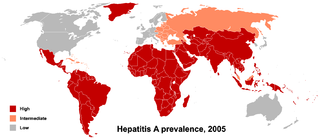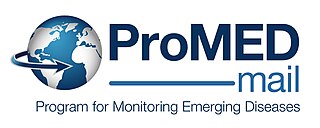Related Research Articles

Epidemiology is the study and analysis of the distribution, patterns and determinants of health and disease conditions in a defined population.

In epidemiology, an outbreak is a sudden increase in occurrences of a disease when cases are in excess of normal expectancy for the location or season. It may affect a small and localized group or impact upon thousands of people across an entire continent. The number of cases varies according to the disease-causing agent, and the size and type of previous and existing exposure to the agent. Outbreaks include many epidemics, which term is normally only for infectious diseases, as well as diseases with an environmental origin, such as a water or foodborne disease. They may affect a region in a country or a group of countries. Pandemics are near-global disease outbreaks when multiple and various countries around the Earth are soon infected.

Health geography is the application of geographical information, perspectives, and methods to the study of health, disease, and health care. Medical geography, a sub-discipline of or sister field of health geography, focuses on understanding spatial patterns of health and disease as related to the natural and social environment. Conventionally, there are two primary areas of research within medical geography: the first deals with the spatial distribution and determinants of morbidity and mortality, while the second deals with health planning, help-seeking behavior, and the provision of health services.

The European Centre for Disease Prevention and Control (ECDC) is an agency of the European Union (EU) whose mission is to strengthen Europe's defences against infectious diseases. It covers a wide spectrum of activities, such as: surveillance, epidemic intelligence, response, scientific advice, microbiology, preparedness, public health training, international relations, health communication, and the scientific journal Eurosurveillance. The centre was established in 2004 and is headquartered in Solna, Sweden.
E-epidemiology is the science underlying the acquisition, maintenance and application of epidemiological knowledge and information using digital media such as the internet, mobile phones, digital paper, digital TV. E-epidemiology also refers to the large-scale epidemiological studies that are increasingly conducted through distributed global collaborations enabled by the Internet.
Spatial epidemiology is a subfield of epidemiology focused on the study of the spatial distribution of health outcomes; it is closely related to health geography.

Disease surveillance is an epidemiological practice by which the spread of disease is monitored in order to establish patterns of progression. The main role of disease surveillance is to predict, observe, and minimize the harm caused by outbreak, epidemic, and pandemic situations, as well as increase knowledge about which factors contribute to such circumstances. A key part of modern disease surveillance is the practice of disease case reporting.
A notifiable disease is any disease that is required by law to be reported to government authorities. The collation of information allows the authorities to monitor the disease, and provides early warning of possible outbreaks. In the case of livestock diseases, there may also be the legal requirement to kill the infected livestock upon notification. Many governments have enacted regulations for reporting of both human and animal diseases.
The European Programme for Intervention Epidemiology Training (EPIET) Fellowship provides training and practical experience in intervention epidemiology at the national centres for surveillance and control of communicable diseases in the European Union. The fellowship is aimed at EU medical practitioners, public-health nurses, microbiologists, veterinarians and other health professionals with previous experience in public health and a keen interest in epidemiology.

Program for Monitoring Emerging Diseases is among the largest publicly available emerging diseases and outbreak reporting systems in the world. The purpose of ProMED is to promote communication amongst the international infectious disease community, including scientists, physicians, veterinarians, epidemiologists, public health professionals, and others interested in infectious diseases on a global scale. Founded in 1994, ProMED has pioneered the concept of electronic, Internet-based emerging disease and outbreak detection reporting. In 1999, ProMED became a program of the International Society for Infectious Diseases. As of 2016, ProMED has more than 75,000 subscribers in over 185 countries. With an average of 13 posts per day, ProMED provides users with up-to-date information concerning infectious disease outbreaks on a global scale.

Field Epidemiology is the application of epidemiologic methods to unexpected health problems when a rapid on-site investigation is necessary for timely intervention. A more expansive definition is: The practice of Epidemiology in the field. Work is done in communities often as a public health service and as part of government or a closely allied institution. Field epidemiology is how epidemics and outbreaks are investigated, and is used to implement measures to protect and improve the health of the public. Field epidemiologists must deal with unexpected, sometimes urgent problems that demand immediate solution. Its methods are designed to answer specific epidemiologic questions in order to plan, implement, and/or evaluate public health interventions. These studies consider the needs of those who will use the results. The task of a field epidemiologist is not complete until the results of a study have been clearly communicated in a timely manner to those who need to know, and an intervention made to improve the health of the people.
Surveillance for communicable diseases is the main public health surveillance activity in China. Currently, the disease surveillance system in China has three major components:

The National Centre for Disease Control is an institute under the Indian Directorate General of Health Services, Ministry of Health and Family Welfare. It was established in July 1963 for research in epidemiology and control of communicable diseases and to reorganize the activities of the Malaria Institute of India. It has nine branches at Alwar, Bengaluru, Trivandrum, Calicut, Coonoor, Jagdalpur, Patna, Rajahmundry and Varanasi to advise the respective state governments on public health. The headquarters are in Sham Nath Marg, in New Delhi.
The Mekong Basin Disease Surveillance (MBDS) consortium is a self-organised and sub-regional co-operation spearheaded by health ministries from member countries to collaborate on infectious disease surveillance and control. The co-operation focuses on cross-border co-operation at selected sites and has matured through several phases of work. PRO/MBDS is a component of the outbreak reporting system ProMED-mail.
Sanitary epidemiological reconnaissance, synonym epidemiological reconnaissance is a literal name of a concept and routine of finding out disease potential on a territory of arrival of major contingent. Russian: санитарно-эпидемиологическая разведка, син. эпидемиологическая разведка. This is a kind of medical reconnaissance, process of information gathering on possible infectious diseases' origin-sources, the ways and factors of the infection transfer and determining all conditions that could have promoted the spread of infestation among army service personnel. In 1939 Academician E.N.Pavlovsky announced his "doctrine of nidality", so called by Soviet biologists. People can acquire zoonoses and insect-borne diseases when they occupy at certain times of the year natural habitat of a certain pathogen. The WHO Expert Committee on Zoonoses listed over 100 such diseases. About natural focality of the diseases is known elsewhere.
The Nigeria Centre for Disease Control (NCDC) is the national public health institute for Nigeria. It is a federal government agency under the Federal Ministry of Health (Nigeria), with its headquarters in Abuja, Federal Capital Territory.
John Brownstein is a Canadian epidemiologist and Professor of Medicine at the Harvard Medical School as well as the Chief Innovation Officer at Boston Children’s Hospital. His research focuses on development of computational methods in epidemiology for applications to public health also known as computational epidemiology or e-epidemiology He is also the founder of several global public health surveillance systems including HealthMap. He is most known for his work on global tracking of disease outbreaks.
The Health Protection Surveillance Centre (HPSC) is part of Ireland's Health Service Executive.

The Weekly Epidemiological Record (WER) is a publication of the World Health Organization (WHO) that as of 2020 is in its 95th volume. It is published in English and French with the alternative title of the Relevé épidémiologique hebdomadaire. It aims to rapidly disseminate epidemiological information about outbreaks of diseases under the International Health Regulations and about communicable diseases of public health importance. This includes emerging or re-emerging diseases.
Acoustic epidemiology refers to the study of the determinants and distribution of disease. It also refers to the analysis of sounds produced by the body through a single tool or a combination of diagnostic tools.
References
- 1 2 3 4 5 6 Marechal, F., Ribeiro, N., Lafaye, M., Guell, A. (2008) Satellite imaging and vector-borne diseases: the approach of the French National Space Agency (CNES). Geospatial Health 3(1), 1-5.
- 1 2 3 Keller, M., Blench, M., Tolentino, H., Freifeld, C.C., Mandl, K.D., Mawudeku, A., Eysenbach, G., Brownstein, J.S. (2009) Use of unstructured event-based reports for global infectious disease. Emerging Infectious Diseases 15(5), 689-695.
- ↑ Wiemeken, T.L., Peyrani, P., Ramirez, J.A. (2012)
- 1 2 HealthMap (2012) About HealthMap Last accessed December 14, 2012
- ↑ Butler, D. (2006) Disease surveillance needs a revolution. Nature 440, 6-7.